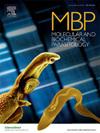硫代氨基脲酮和噻唑烷酮对曼氏血吸虫幼虫和成虫体外杀虫活性和超微结构改变的合成(Sambon, 1907)。
IF 1.4
4区 医学
Q4 BIOCHEMISTRY & MOLECULAR BIOLOGY
引用次数: 2
摘要
血吸虫病是一种被忽视的疾病,影响着全世界约2.58亿人。由曼森血吸虫引起,这种寄生虫在巴西的19个州和首都都有。吡喹酮(PZQ)治疗寄生虫幼期疗效低,且有不良反应。硫代氨基脲类和噻唑烷酮类作为具有广谱生物活性的强有力的化学基团正在崛起,通过自由基修饰,它们可能变得更加有效和选择性。为了评价这些分子对曼氏梭菌的作用,合成了JF系列硫代氨基脲酮和噻唑烷酮(LqIT/UFPE): JF30、JF31、JF33、JF34、JF35、JF36、JF38、JF39、JF42和JF43。研究了其在VERO细胞中的细胞毒性、对幼虫和成虫的体外杀虫活性以及通过超微结构变化对虫体的作用。细胞毒性指标范围为272µM ~ 725µM。结果表明,JF31和JF43分别在200µM的剂量下,在24h和48h内成虫和幼虫的死亡率均为100%。同时,对JF31和JF43的运动、死亡率和产卵参数进行了评估:JF31和JF43在24小时内得分为0,表示完全不运动,光学显微镜下未观察到卵和软组织损伤。通过扫描电镜观察到化合物JF31和JF43对被膜的影响,如:暴露于肌肉组织,形成被膜气泡,被膜形态异常,结节和尖刺破坏。结果表明,化合物JF31对成虫的选择性高2.39倍,JF43对幼虫的选择性高3.74倍。因此,化合物JF43和JF31最有可能表现出曼氏梭菌的杀血吸虫活性。本文章由计算机程序翻译,如有差异,请以英文原文为准。
Synthesis, in vitro Schistosomicidal Activity and Ultrastructural Alterations Caused by Thiosemicarbazones and Thiazolidinones Against Juvenile and Adult Schistosoma mansoni Worms (Sambon, 1907).
Schistosomiasis is a neglected disease that affects about 258 million people worldwide. Caused by Schistosoma mansoni, helminth which, in Brazil, it is present on 19 states and capital. Praziquantel (PZQ) treatment presents low efficacy and adverse effects in parasites juvenile stages. Thiosemicarbazones and thiazolidinones are rising as potent chemical groups that have biological activity wide spectrum, and with radical modifications, they may become more effective and selective. Aiming to evaluate the action of these molecules against S. mansoni, JF series thiosemicarbazones and thiazolidinones (LqIT/UFPE) were synthesized: JF30, JF31, JF33, JF34, JF35, JF36, JF38, JF39, JF42 and JF43. Several parameters were evaluated, such as: their cytotoxicity in VERO cells, in vitro schistosomicidal activity for juvenile and adult worms and their action on worms through ultrastructural changes. Cytotoxicity indices ranged from 272µM to 725µM. When evaluating mortality rate, adult and juvenile worms showed 100% mortality rate within 24h and 48h, respectively, when exposed to the compounds JF31 and JF43 at a dose of 200µM. Also, motility, mortality and oviposition parameters were evaluated: JF31 and JF43 presented a score of 0 in 24h, meaning total absence of movement, whereas no eggs and soft tissue damage were observed under optical microscopy. Through scanning electron microscopy, integumentary alterations caused by the compounds JF31 and JF43 were observed, such as: exposure of the musculature, formation of integumentary bubbles, integuments with abnormal morphology and destruction of tubercles and spikes. The results shoerd that the compound JF31 was 2.39 times more selective for adult worms and JF43 was 3.74 times more selective for juvenile worms. Thus, the compounds JF43 and JF31 are the most promising for presenting schistosomicidal activity of S. mansoni.
求助全文
通过发布文献求助,成功后即可免费获取论文全文。
去求助
来源期刊
CiteScore
2.90
自引率
0.00%
发文量
51
审稿时长
63 days
期刊介绍:
The journal provides a medium for rapid publication of investigations of the molecular biology and biochemistry of parasitic protozoa and helminths and their interactions with both the definitive and intermediate host. The main subject areas covered are:
• the structure, biosynthesis, degradation, properties and function of DNA, RNA, proteins, lipids, carbohydrates and small molecular-weight substances
• intermediary metabolism and bioenergetics
• drug target characterization and the mode of action of antiparasitic drugs
• molecular and biochemical aspects of membrane structure and function
• host-parasite relationships that focus on the parasite, particularly as related to specific parasite molecules.
• analysis of genes and genome structure, function and expression
• analysis of variation in parasite populations relevant to genetic exchange, pathogenesis, drug and vaccine target characterization, and drug resistance.
• parasite protein trafficking, organelle biogenesis, and cellular structure especially with reference to the roles of specific molecules
• parasite programmed cell death, development, and cell division at the molecular level.

 求助内容:
求助内容: 应助结果提醒方式:
应助结果提醒方式:


